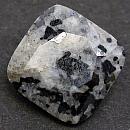|
|
||||||||||||||||
|
||||||||||||||||
|
||||||
|
|
|
|
Hardystonite
|
|
| | |
| Discovered in 1899; IMA status: Valid (pre-IMA; Grandfathered) | ||
|
| ||
|
Chemistry |
|
|
| |
|
Ca2ZnSi2O7 | |
|
|
Calcium Zinc Silicate |
|
Molecular Weight: |
313.71 gm |
|
Composition: |
Calcium |
25.55 % |
Ca |
35.75 % |
CaO |
|
|
Zinc |
20.84 % |
Zn |
25.94 % |
ZnO |
|
|
Silicon |
17.91 % |
Si |
38.31 % |
SiO2 |
|
|
Oxygen |
35.70 % |
O |
|
|
|
|
|
100.00 % |
|
100.00 % |
= TOTAL OXIDE |
|
|
|
||||
|
Classification |
|
|
| |
|
Silicates (Germanates) | |
|
8/C.02-40 | |
|
|
9 : SILICATES (Germanates)
|
|
Related to: |
Melilite Group. |
|
Members of Group: |
Melilite Group: ┼kermanite, Alumoňkermanite, Gehlenite, Gugiaite, Hardystonite, Okayamalite |
|
Varieties: |
None |
|
Synonyms: |
None |
|
|
|
|
Crystal Data |
|
|
|
|
|
In coarse, columnar masses; granular and as isolated grains. |
|
|
None |
|
|
|
|
|
Physical Properties |
|
|
|
|
|
Good on {001}, Poor on {100} and {110} |
|
|
Irregular/Uneven |
|
|
Brittle |
|
|
3.0 - 4.0 |
|
|
3.396 - 3.443 (g/cm3) |
|
|
Fluorescent; dull to dark purple under SW UV, blue to violet blue under LW UV |
|
|
Not Radioactive |
|
|
|
|
|
Optical Properties |
|
|
|
|
|
White, pale pinkish, light brownish white, grayish white; colorless in thin section. |
|
|
Translucent |
|
|
Vitreous, Resinous, Dull |
|
|
1.657 - 1.672 Uniaxial ( - ) |
|
|
0.011 |
|
|
n/a |
|
|
None |
|
|
|
|
|
Occurances |
|
|
|
|
|
Geological Setting: |
In granular ore in a metamorphosed stratiform zinc deposit. |
|
Common Associations: |
Vesuvianite, Apatite, Franklinite, Willemite, Rhodonite, Calcite, Dolomite |
|
Common Impurities: |
Al, Fe, Mn, Pb, Mg, Na |
|
Type Locality: |
Franklin Mine, Franklin, Franklin Mining District, Sussex Co., New Jersey, USA |
|
Year Discovered: |
1899 |
|
View mineral photos: | |
|
|
|
|
More Information |
|
|
|
|
|
| |
|
|
|
|
Hardystonite is often found in association with other fluorescent minerals such as Calcite, Clinoherderite, Esperite, Fluorite, Willemite and Wollastonite. When two or more of these minerals are found together in one specimen it can make for wonderfully colorful fluorescent specimens. The purple or violet-blue color of Hardystonite really stands out among these minerals. Distribution:
From the type locality at Franklin Mine, Sussex County, New Jersey, USA.
At Vrchlice River valley, Policany, Kutna Hora, Central
Bohemian Region, Czech Republic. At Gottesbelohnung smelter,
Hettstedt, Mansfeld Basin, Saxony-Anhalt, German. At
Tsumeb, Otjikoto Region, Namibia. At Swietochlowice,
Katowice, Upper Silesia (Slaskie), Poland. |
|
|
We
have not photographed our Hardystonite gems yet. Please
check back soon. |
